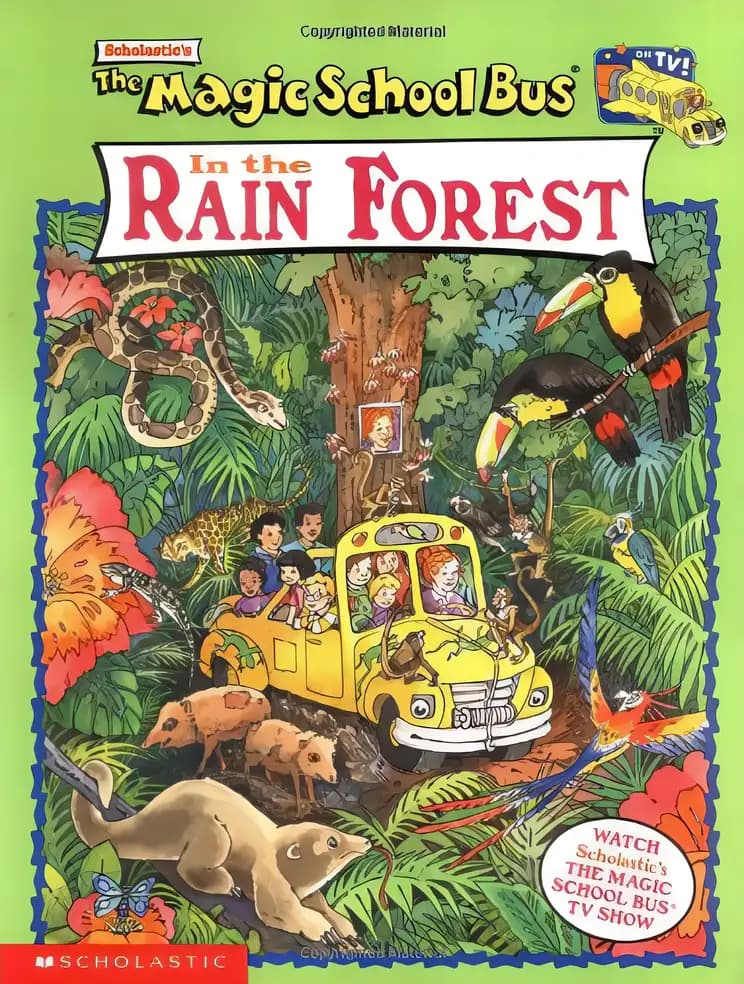The Magic School Bus In The Rain Forest
#4 of 13 in Magic School Bus Series
What’s inside...
Join Ms. Frizzle and her class as they take a field trip to the rainforest and learn about the plants, animals and ecosystem that thrive there. When Ms. Frizzle takes the class to the rain forest to find out why her cocoa tree has stopped growing beans, the class learns important lessons about why trees get sick and what are the necessary steps to making them well once more. Original.
Character compass
Ms. Valerie Frizzle
Carlos
Arnold
Ralphie
Phoebe
Tim
Dorothy Ann
Keesha
Discussion points
What did you learn about the rainforest and the types of animals that live there?
Why do you think the rainforest is important for the Earth's environment?
How did Ms. Frizzle's class help solve a problem in the story?
If you could join Ms. Frizzle on a field trip, where would you want to go and why?
What would you do if you were a scientist exploring the rainforest?
Tip: Role play these questions
Encourage your child to relate the story to real life by asking them how they can help preserve environments like rainforests.
While discussing the book, show enthusiasm and curiosity about the topics covered, such as different animal habitats and plant species.
Use the illustrations in the book to point out details and ask your child what they notice, fostering observational skills.
After reading, consider watching a documentary or looking up more information online about rainforests to reinforce learning.
Suggest your child to draw their favorite scene or character from the book, then describe why they chose it.
Key lessons
Example Lesson: Importance of Rainforests
Explanation: The book explores the crucial role rainforests play in our global ecosystem. It follows Ms. Frizzle and her class as they dive into the lush layers of the rainforest, learning about its diverse flora and fauna.
Real-World Application: This lesson can inspire children to learn more about environmental conservation and the role they can play in protecting natural habitats.
Example Lesson: Biodiversity and Ecosystem Interdependence
Explanation: Students learn about different species that inhabit the rainforest and how these species depend on each other and their environment to survive.
Real-World Application: Children can observe and appreciate the interdependence of life in their own surroundings, fostering a sense of responsibility towards maintaining ecosystem balance.
Example Lesson: Science Inquiry and Exploration
Explanation: The story emphasizes the fun and adventure in scientific exploration, as the characters ask questions, make observations, and gather information about the rainforest.
Real-World Application: Encourages children to be curious, ask questions, and explore the natural world around them, enhancing their critical thinking and problem-solving skills.
Example Lesson: Environmental Conservation
Explanation: Through their adventures, the students learn about the threats to rainforests and the importance of conservation efforts.
Real-World Application: Teaches children the value of environmental activism and can motivate them to participate in or initiate conservation efforts in their communities.
Example Lesson: Teamwork and Cooperation
Explanation: As the class navigates through the rainforest, they must work together to overcome challenges, demonstrating the importance of teamwork.
Real-World Application: This can be applied in a child’s everyday life by emphasizing the importance of working cooperatively in group settings, whether in school projects or community activities.
